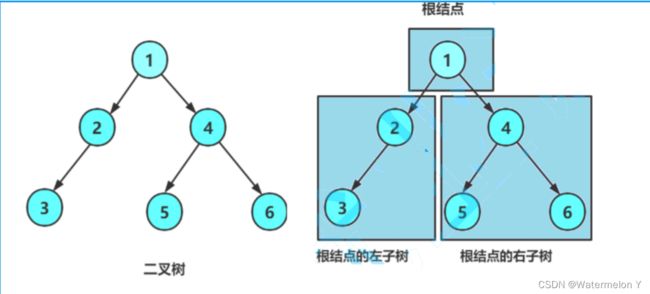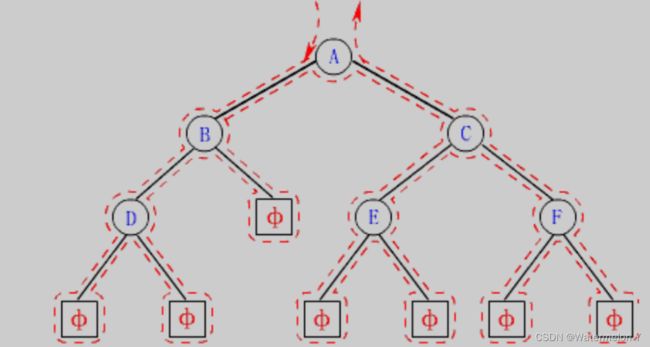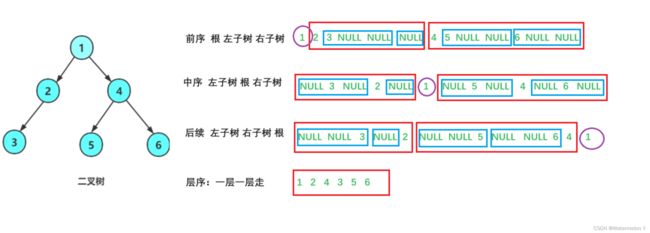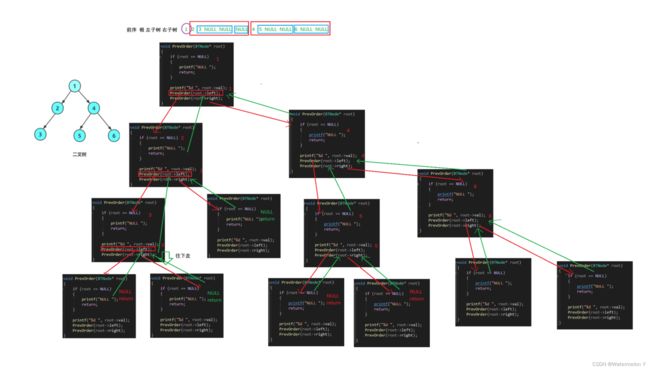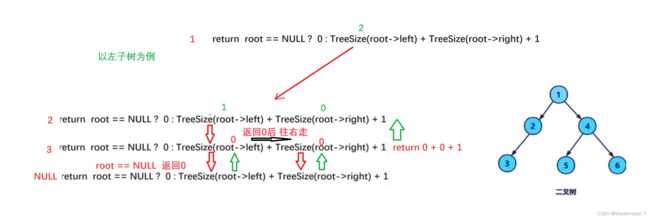【数据结构】二叉树--链式结构的实现 (遍历)
目录
一 二叉树的遍历
1 构建一个二叉树
2 前序遍历
3 中序遍历
4 后续遍历
5 层序
6 二叉树销毁
二 应用(递归思想)
1 二叉树节点个数
2 叶子节点个数
3 第K层的节点个数
4 二叉树查找值为x的节点
5 判断是否是二叉树
一 二叉树的遍历
学习二叉树结构,最简单的方式就是遍历。所谓二叉树遍历(Traversal)是按照某种特定的规则,依次对二叉 树中的节点进行相应的操作,并且每个节点只操作一次。访问结点所做的操作依赖于具体的应用问题。 遍历 是二叉树上最重要的运算之一,也是二叉树上进行其它运算的基础
二叉树是: 1. 空树 2. 非空:根节点,根节点的左子树、根节点的右子树组成的。
前序、中序以及后序遍历:
按照规则,二叉树的遍历有:前序/中序/后序的递归结构遍历:
1. 前序遍历(Preorder Traversal 亦称先序遍历)——访问根结点的操作发生在遍历其左右子树之前。
2. 中序遍历(Inorder Traversal)——访问根结点的操作发生在遍历其左右子树之中(间)。
3. 后序遍历(Postorder Traversal)——访问根结点的操作发生在遍历其左右子树之后。
由于被访问的结点必是某子树的根,所以N(Node)、L(Left subtree)和R(Right subtree)又可解释为 根、根的左子树和根的右子树。NLR、LNR和LRN分别又称为先根遍历、中根遍历和后根遍历。
代码实现:
1 构建一个二叉树
typedef struct BinaryTreeNode
{
struct BinaryTreeNode* left;
struct BinaryTreeNode* right;
int val;
}BTNode;
BTNode* BuyNode(int x)
{
BTNode* node = (BTNode*)malloc(sizeof(BTNode));
if (node == NULL)
{
perror("malloc fail");
exit(-1);
}
node->left = NULL;
node->right = NULL;
node->val = x;
return node;
}
int main()
{
BTNode* node1 = BuyNode(1);
BTNode* node2 = BuyNode(2);
BTNode* node3 = BuyNode(3);
BTNode* node4 = BuyNode(4);
BTNode* node5 = BuyNode(5);
BTNode* node6 = BuyNode(6);
node1->left = node2;
node1->right = node4;
node2->left = node3;
node4->left = node5;
node4->right = node6;
PrevOrder(node1);
printf("\n");
InOrder(node1);
printf("\n");
PostOrder(node1);
printf("\n");
return 0;
}2 前序遍历
//前序遍历
void PrevOrder(BTNode* root)
{
if (root == NULL)
{
printf("NULL ");
return;
}
printf("%d ", root->val);
PrevOrder(root->left);
PrevOrder(root->right);
}
3 中序遍历
//中序遍历
void InOrder(BTNode* root)
{
if (root == NULL)
{
printf("NULL ");
return;
}
InOrder(root->left);
printf("%d ", root->val);
InOrder(root->right);
}4 后续遍历
//后序遍历
void PostOrder(BTNode* root)
{
if (root == NULL)
{
printf("NULL ");
return;
}
PostOrder(root->left);
PostOrder(root->right);
printf("%d ", root->val);
}5 层序
void QueueInit(Que* pq)
{
assert(pq);
pq->head = pq->tail = NULL;
pq->size = 0;
}
void QueuePush(Que* pq, QDataType x)
{
assert(pq);
QNode* newnode = (QNode*)malloc(sizeof(QNode));
if (newnode == NULL)
{
perror("malloc fail");
exit(-1);
}
newnode->next = NULL;
newnode->val = x;
if (pq->tail == NULL)
{
pq->head = pq->tail = newnode;
}
else
{
pq->tail->next = newnode;
pq->tail = newnode;
}
pq->size++;
}
bool QueueEmpty(Que* pq)
{
assert(pq);
return pq->head == NULL;
}
void QueuePop(Que* pq)
{
assert(pq);
assert(!QueueEmpty(pq));
if (pq->head->next == NULL)
{
free(pq->head);
pq->head = pq->tail = NULL;
}
else
{
QNode* next = pq->head->next;
free(pq->head);
pq->head = next;
}
pq->size--;
}
QDataType QueueFront(Que* pq)
{
assert(pq);
assert(!QueueEmpty(pq));
return pq->head->val;
}
void LevelOrder(BTNode* root)
{
Que q;
QueueInit(&q);
if (root)
{
QueuePush(&q, root);
}
while (!QueueEmpty(&q))
{
BTNode* front = QueueFront(&q);
printf("%d ", front->val);
if (front->left)
{
QueuePush(&q, front->left);
}
if (front->right)
{
QueuePush(&q, front->right);
}
QueuePop(&q);
}
}
6 二叉树销毁
//二叉树的销毁
void TreeDestroy(BTNode* root)
{
if (root == NULL)
{
return;
}
TreeDestroy(root->left);
TreeDestroy(root->right);
free(root);
}二 应用(递归思想)
1 二叉树节点个数
int size = 0;
int TreeSize(BTNode* root)
{
if (root == NULL)
{
return 0;
}
else
{
size++;
}
TreeSize(root->left);
TreeSize(root->right);
return size;
}我们还可以改进
int TreeSize(BTNode* root)
{
return root == NULL ? 0 : TreeSize(root->left) + TreeSize(root->right) + 1;
}2 叶子节点个数
int TreeLeafSize(BTNode* root)
{
if (root == NULL)
{
return 0;
}
if (root->left == NULL && root->right == NULL)
{
return 1;
}
return TreeLeafSize(root->left) + TreeLeafSize(root->right);
}3 第K层的节点个数
int TreeKLevel(BTNode* root, int k)
{
assert(k > 0);
if (root == NULL)
{
return 0;
}
if (k == 1)
{
return 1;
}
return TreeKLevel(root->left, k-1) + TreeKLevel(root->right, k-1);
}
4 二叉树查找值为x的节点
BTNode* TreeFind(BTNode* root, int x)
{
if (root == NULL)
{
return NULL;
}
if (root->val == x)
{
return root;
}
BTNode* ret = NULL;
//从左树找 找到了就返回 不找右树了
ret = TreeFind(root->left, x);
if (ret)
{
return ret;
}
//左树没找到 就开始找右树
ret = TreeFind(root->right, x);
if (ret)
{
return ret;
}
}5 判断是否是二叉树
void QueueInit(Que* pq)
{
assert(pq);
pq->head = pq->tail = NULL;
pq->size = 0;
}
void QueueDestroy(Que* pq)
{
assert(pq);
QNode* cur = pq->head;
while (cur)
{
QNode* next = cur->next;
free(cur);
cur = next;
}
pq->head = pq->tail = NULL;
pq->size = 0;
}
void QueuePush(Que* pq, QDataType x)
{
assert(pq);
QNode* newnode = (QNode*)malloc(sizeof(QNode));
if (newnode == NULL)
{
perror("malloc fail");
exit(-1);
}
newnode->next = NULL;
newnode->val = x;
if (pq->tail == NULL)
{
pq->head = pq->tail = newnode;
}
else
{
pq->tail->next = newnode;
pq->tail = newnode;
}
pq->size++;
}
bool QueueEmpty(Que* pq)
{
assert(pq);
return pq->head == NULL;
}
void QueuePop(Que* pq)
{
assert(pq);
assert(!QueueEmpty(pq));
if (pq->head->next == NULL)
{
free(pq->head);
pq->head = pq->tail = NULL;
}
else
{
QNode* next = pq->head->next;
free(pq->head);
pq->head = next;
}
pq->size--;
}
QDataType QueueFront(Que* pq)
{
assert(pq);
assert(!QueueEmpty(pq));
return pq->head->val;
}
int TreeComplete(BTNode* root)
{
Que q;
QueInit(&q);
if (root != NULL)
{
QueuePush(&q, root);
}
//找空节点
while (!QueueEmpty(&q))
{
BTNode* front = QueueFront(&q);
if (front == NULL)
{
break;
}
QueuePush(&q, front->left);
QueuePush(&q, front->right);
QueuePop(&q);
}
//已经找到空节点
while (!QueueEmpty(&q))
{
BTNode* front = QueueFront(&q);
QueuePop(&q);
if (front != NULL)
{
QueueDestroy(&q);
return false;
}
}
QueueDestroy(&q);
return true;
}二叉树的链式结构的本质思想是递归, 对于递归不了解的小伙伴可以看看我之前的博客, 也可以自己尝试画一下递归展开图,下一节讲OJ题目.实战才最有效!继续加油!
